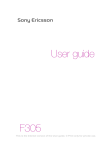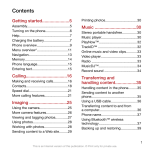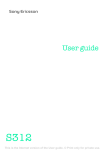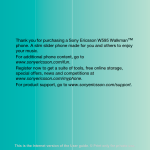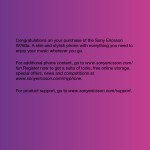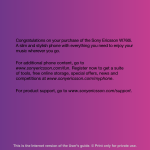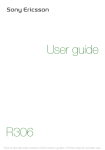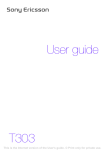Download Sony Ericsson S302 User Guide
Transcript
User guide S302 This is the Internet version of the User guide. © Print only for private use. Thank you for purchasing a Sony Ericsson S302. For additional phone content, go to www.sonyericsson.com/fun. Register now to get free online storage and special offers at www.sonyericsson.com/myphone. For product support, go to www.sonyericsson.com/support. Instruction symbols The following appear in this User guide: > Use the navigation key to scroll and select Press the centre selection key Press the navigation key up Press the navigation key down Press the navigation key to the left Press the navigation key to the right Note Tip Warning Indicates that a service or function is network- or subscription-dependent. All menus or functions may not be available in your phone. Consult your network operator for more information. 2 This is the Internet version of the User guide. © Print only for private use. SIM card The SIM (Subscriber Identity Module) card, which you get from your network operator, contains information about your subscription. Always turn off your phone and detach the charger and the battery before you insert or remove the SIM card. You can save contacts on the SIM card before removing it from your phone. You can also save contacts in the phone memory. See Contacts on page 22. PIN code (SIM card lock) The PIN (Personal Identification Number) code is a SIM card lock that protects your subscription, but not the phone itself. If the card is locked, you have to enter the PIN code when you turn on your phone. To change your PIN code, see SIM card lock on page 36. Each PIN digit appears as *, unless it starts with emergency number digits, for example, 112 or 911. You can call an emergency number without entering a PIN. If you enter the wrong PIN three times in a row, PIN blocked appears. To unblock it, you need to enter your PUK (Personal Unblocking Key). 3 This is the Internet version of the User guide. © Print only for private use. Charging the battery The phone battery is partly charged when you buy it. It takes approximately 2.5 hours to fully charge the battery. To charge the battery 1 Connect the charger to the phone with the power icon on the charger facing upwards. Press a key to illuminate the screen and see the charging status. 2 To remove the charger, tilt and pull the plug upwards. The battery icon on the screen may not appear until the phone has charged for 30 minutes. You can use the phone during charging. You can charge the battery for more or less than 2.5 hours. Interrupted charging will not damage the battery. 4 This is the Internet version of the User guide. © Print only for private use. Memory Stick Micro™ Your phone supports Memory Stick Micro™ (M2™). A memory card adds more storage space to your phone, for example, music, ringtones, video clips and pictures. You can share your saved information by moving or copying it to other memory card compatible devices. To insert Memory Stick Micro™ (M2™) • Open the cover and insert the memory card (with the goldcoloured contacts facing down). To remove a Memory Stick Micro™ (M2™) • Press the edge to release and remove. 5 This is the Internet version of the User guide. © Print only for private use. Turning on the phone To turn on the phone 1 Press and hold down . 2 Enter your SIM card PIN, if requested. 3 Select Yes to use the setup wizard. If you make a mistake when you enter your PIN, you can press to delete numbers from the screen. Standby After you have turned on the phone and entered your PIN, the name of your operator appears on the screen. This is called standby. You can now make and receive calls. To turn the phone off • Press and hold down . If your phone cannot turn on, attach the charger and charge the phone for 2.5 hours. If your phone turns itself off when being transported, turn the automatic keylock on. This prevents things in your pocket or bag from activating the on/off key accidentally. 6 This is the Internet version of the User guide. © Print only for private use. Network coverage Network coverage Battery status The network bars show the strength of the GSM network in your area. Move to another location if you have problems calling and network coverage is poor. No network means you are not in range of a network. = Good network coverage = Average network coverage Battery status = The phone battery is fully charged = The phone battery is empty If you cannot turn on the phone, attach the charger properly and try charging the phone until it has finished charging. 7 This is the Internet version of the User guide. © Print only for private use. Screen icons These icons may appear on the screen. Icon Description Ongoing call Missed call Handsfree connected Phone set to silent Predictive text input activated Text message received Picture message received Email message received Voice message received FM radio playing Alarm activated Bluetooth function activated 8 This is the Internet version of the User guide. © Print only for private use. Phone overview 1 Ear speaker 2 Music key 3 Screen 4 Selection keys 5 Call key 6 Shortcuts menu key 3 7 Connector for charger, handsfree and USB cable 4 8 Navigation key 9 Centre selection key 5 11 keys/camera 10 Volume zoom keys 6 12 7 13 On/off key 11 End call key 12 C key (Clear) 13 Camera key/video recorder key 1 2 10 8 9 14 14 Silent key 9 This is the Internet version of the User guide. © Print only for private use. Key Go to the main menus or select items Scroll between the menus and tabs Select options shown immediately above these keys on the screen Delete items, such as pictures, sounds and contacts. On the side: Press to stop or play music when in the Music player mode Press to mute or unmute the radio. Works only if an audio accessory is connected Press to move between the Music player and standby My shortcuts – add your favourite functions to access them quickly From standby press to activate Camera and video recorder Press and hold down to turn the phone on/off Press to end a call Press to make a call after you gave entered the phone number 10 This is the Internet version of the User guide. © Print only for private use. Navigation The main menus are shown as icons. Some submenus include tabs. To navigate the phone menus 1 From standby select Menu. 2 Use the navigation key to move through the menus. To scroll between the tabs • Press the navigation key left or right. To go back one step in the menu • Select Back. To return to standby • Press . To lock the keypad • Press and select Lock. To unlock the keypad • Press and select Unlock. To set the phone to silent • Press and hold down . To call your voicemail service • Press and hold down . To end a function • Press . 11 This is the Internet version of the User guide. © Print only for private use. Menu overview PlayNow™* Internet* Entertainment Homepage, Enter address, Bookmarks, History, Saved pages, Internet settings Games, TrackID™, Video player, Record sound Camera Messaging Write new, Inbox, Email, Drafts, Outbox, Sent messages, Call voicemail, Templates, Settings Music player File manager** All files, On mem. card, In phone Contacts New contact Radio Calls** All Dialled Organiser Missed Answered Alarm, Applications, Calendar, Tasks, Synchronisation*, Timer, Stopwatch, Light, Calculator 12 This is the Internet version of the User guide. © Print only for private use. Settings** General Profiles Time & date Phone language Shortcuts Flight mode Security Phone status Reset all Sounds & alerts Ring volume Ringtone Silent mode Vibrating alert Message alert Key sound Calls Speed dial Divert calls Manage calls Time & cost* Show/hide no. Handsfree Connectivity Bluetooth USB Synchronisation* Mobile networks Internet settings Display Wallpaper Themes Startup screen Screen saver Brightness *Some menus are operator-, network- and subscription-dependent. ** You can use the navigation key to scroll between tabs in submenus. For more information, see Navigation on page 11. 13 This is the Internet version of the User guide. © Print only for private use. Radio Do not use your phone as a radio in places where it is prohibited. To listen to the radio 1 Connect the handsfree to the phone. 2 From standby select Menu > Radio. To control the radio • Press or to search for FM radio channels. To save an FM radio channel • Select Options > Save. • Scroll to a position and press Select. To listen to a saved FM radio channel • When the FM radio is on, press – . To exit the FM radio 1 Select Back or press . 2 Minimise radio? appears. Select No. To turn the FM radio off when minimised 1 Select Menu > Radio. 2 Select Back or press . 3 Minimise radio? appears. Select No. To view FM radio options • When the FM radio is on, select Options. 14 This is the Internet version of the User guide. © Print only for private use. Imaging Camera and video recorder You can take pictures and record video clips to view, save or send. You can find your saved pictures and video clips in Menu > File manager > Camera album. 1 Zoom in or out, works only in VGA mode 2 Press to take another picture 3 Take pictures/Record video clips 4 Screen options To take a picture 1 Activate the camera. 2 Use the navigation key to select . 3 Press to take a picture. 4 Select to take another picture. 15 This is the Internet version of the User guide. © Print only for private use. To use the zoom • Press the volume keys up or down. Do not record with a strong light source in the background. Use a support or the self-timer to avoid a blurred picture. When taking a picture, zoom is available in VGA mode only. Camera settings You can select different settings before you take a picture or record a video clip. 1 When the camera is activated, select . 2 Use the navigation key to select camera settings. To use the camera light you must turn it on manually. To stop using the camera light you turn it off manually. To record a video clip 1 Activate the camera. 2 Use the navigation key to select . 3 Press fully down to start recording. The video clip is automatically saved on the memory card, if a memory card is inserted. If not, the video clip is saved in the phone memory. To stop recording • Press . The video clip is automatically saved on the memory card. 16 This is the Internet version of the User guide. © Print only for private use. To delete pictures and video clips 1 From standby select Menu > File manager > Camera album. 2 Scroll to an item and press . Photo fix You can improve an under-exposed picture with Photo fix. To improve a picture with Photo fix 1 Activate the camera. 2 Take a picture. 3 Find the picture in Camera album. 4 Select Options > Photo fix. Picture blog A picture blog is a personal Web page. If your subscription supports this service, you can send pictures to a blog. Web services may require a separate license agreement between you and the service provider. Additional regulations and/or charges may apply. Contact your service provider. To send camera pictures to a blog 1 From standby select Menu > File manager > Camera album. 2 Scroll to a picture and select Options > Send > To blog. 3 Add title and select Edit. 4 Add text and select Edit. 5 Select OK > Publish. 17 This is the Internet version of the User guide. © Print only for private use. To go to a blog address from contacts 1 From standby select Menu > Contacts. 2 Select a contact. 3 Scroll to a Web address and select Go to. To transfer pictures to and from your computer You can use Bluetooth™ wireless technology and the USB cable to transfer pictures and video clips between your computer and phone. See Bluetooth™ on page 31 and To transfer files on page 26 for more information. Pictures and video clips You can add a picture of a contact, use it during phone-start up, as a wallpaper in standby or as a screen saver. To use pictures 1 From standby select Menu > File manager > Pictures. 2 Scroll to a picture and select Options > Use as. 3 Select an option. Make sure the receiving device supports the transfer method you select. 18 This is the Internet version of the User guide. © Print only for private use. Calling You must turn on the phone and be within range of a network. To make a call 1 From standby enter a phone number (with international country code and area code, if applicable). 2 Press . You can call numbers from your contacts and call list. See Contacts on page 22, and Call list on page 20. To end a call • Press . To answer a call • Press . To reject a call • Press . To change the ear speaker volume during a call • Press the volume key up or down. To turn the loudspeaker on during a call • Select SpkrOn. Do not hold the phone to your ear when using the loudspeaker. This could damage your hearing. 19 This is the Internet version of the User guide. © Print only for private use. To make international calls 1 From standby press and hold down until a + sign appears on the screen. 2 Enter the country code, area code (without the first zero) and phone number. 3 Press . To view missed calls from standby • When Missed calls: is displayed, select View. To call back scroll to the number and press . Call list You can view information about recent calls. To call a number from the call list 1 From standby press . 2 Scroll to the name or number and press To delete a number from the call list 1 From standby press . 2 Scroll to the name or number and press . > Yes. 20 This is the Internet version of the User guide. © Print only for private use. Internet You need the correct Internet settings in your phone. If the settings are not in your phone, you can: • Get them in a text message from the network operator. • On a computer, go to www.sonyericsson.com/support and request a text message with the settings. To select an Internet profile 1 From standby select Menu > Internet > Internet settings > Accounts. 2 Select an account. To start browsing 1 From standby select Menu > Internet. 2 Select an option: Homepage – go to the predefined homepage. Enter address – enter a Web address. Bookmarks – go directly to a saved Web page. History – show previously visited pages. Saved pages – go directly to a saved Web page. Internet settings – select options such as accounts, connection time, White list. To stop browsing • When you are browsing, press and hold down . 21 This is the Internet version of the User guide. © Print only for private use. Contacts You can save contacts in the phone memory or on the SIM card. You can copy contacts from the phone memory to the SIM card or from the SIM card to the phone memory. Default contacts You can choose which contact information is shown as default. If Phone contacts is selected as default, your contacts show all the information saved in Contacts. If you select SIM contacts as default, your contacts show names and numbers saved on the SIM card. To select default contacts 1 From standby select Menu > Contacts > Options > Advanced > Default contacts. 2 Select an option. See Entering text on page 33. Contacts memory The number of entries you can save in Contacts depends on the capacity of your SIM card. To check the Contacts memory status • From standby select Menu > Contacts > Options > Memory status. 22 This is the Internet version of the User guide. © Print only for private use. Phone contacts Phone contacts can contain names, phone numbers and personal information. They are saved in the phone memory. To add a phone contact 1 From standby select Menu > Contacts > New contact. 2 Scroll to Last name: and select Add. 3 Enter the name and select OK. 4 Scroll to First name: and select Add. 5 Enter the name and select OK. 6 Scroll to New number: and select Add. 7 Enter the number and select OK. 8 Select Save. Enter the + sign and country code with all phonebook numbers. Then you can use them abroad or at home. See To make international calls on page 20. To call a contact 1 From standby select Menu > Contacts. 2 Scroll to, or enter the first few letters of, the contact. 3 Press . To edit a contact 1 From standby select Menu > Contacts. 2 Select a contact. 3 Select Options > Edit contact. 4 Edit the information and select Save. 23 This is the Internet version of the User guide. © Print only for private use. To delete a contact 1 From standby select Menu > Contacts. 2 Select a contact. 3 Select Options > Delete. To copy contacts to the SIM card 1 From standby select Menu > Contacts. 2 Scroll to a contact. 3 Select Options > More > Copy to SIM. To view your own phone number • From standby select Menu > Contacts > Options > My numbers. Emergency calls Your phone supports international emergency numbers, for example, 112 and 911. These numbers can normally be used to make emergency calls in any country, with or without the SIM card inserted, if a GSM network is within range. To make an emergency call • From standby enter the international emergency number, for example 112 and press . In some countries, other emergency numbers may also be promoted. Your network operator may therefore have saved additional local emergency numbers on the SIM card. 24 This is the Internet version of the User guide. © Print only for private use. Music player The file types supported are: MP3, MP4, 3GP, AAC, AMR, MIDI, IMY, EMY and WAV (16 kHz maximum sample rate). You can also use streamed files that are 3GPP compatible. Transferring music You can transfer music from your computer to your phone memory or Memory Stick Micro™ (M2™). There are two ways to connect the phone to a computer: • using a USB cable • with a Bluetooth wireless technology connection You can drag and drop files between your phone or memory card and a computer in Microsoft® Windows Explorer. To connect your phone to a computer using a USB cable 1 Make sure your phone is turned on. 2 Connect the USB cable to your phone and the computer. 3 Phone: Select Mass storage. 4 Computer: Wait for the drivers to be installed (this is done automatically). The first time you connect your phone to the computer, you may need to identify and name the phone. Memory card Phone memory 25 This is the Internet version of the User guide. © Print only for private use. To transfer files 1 Connect the USB cable to the phone and the computer. 2 Phone: From standby select Menu > Settings > the Connectivity tab > USB > Mass storage. 3 Computer: Wait until the phone memory and memory card appear as external disks in Microsoft Windows Explorer. 4 Computer: On the computer desktop, double-click the My Computer icon. 5 Computer: To view the phone memory and memory card folders, double-click the icon representing your phone under Devices with removable storage. Double-click on the removable disk to view M2 folders. 6 Copy and paste your file, or drag and drop it, into the folder you want on your computer, in your phone memory or on your memory card. 7 To safely disconnect the USB cable in File transfer mode, right-click the Removable Disk icon in Windows Explorer and select Eject. Do not remove the USB cable from the phone or computer during transfer, as this may corrupt the memory card and the phone memory. You cannot view the transferred files in your phone until you have removed the USB cable from the phone. More information about transferring files to your phone is available at www.sonyericsson.com/support. 26 This is the Internet version of the User guide. © Print only for private use. To Play Music 1 From standby select Menu > Music player > Options > My music > Tracks. 2 Scroll to a title and select Play. To stop playing music • Press the centre navigation key. To move between track • Press or . Browsing files From standby select Menu > Music player > Options > My music. Music is saved and categorized: • Artists – list music by artist. • Albums – list music by album. • Tracks – list all music tracks. • My playlists – create own lists of tracks. • Onl.channels – list of bookmarks with streaming video or music. Playlists To organise the media files that are saved in File manager, you can create playlists. To create a playlist 1 From standby select Menu > Music player > Options > My music > My playlists > New playlist. 2 Enter a name and select OK. 3 Scroll to a track and select OK. 27 This is the Internet version of the User guide. © Print only for private use. PlayNow™ With PlayNow™ you can preview, buy and download music via the Internet. You can find PlayNow™ in Menu > PlayNow™. You need the correct Internet settings in your phone to use this function. See Internet on page 21. TrackID™ TrackID™ is a music recognition service. You can search for song titles, artists and album names. You need the correct Internet settings in your phone to use this function. See Internet on page 21. To search for song information • When you hear a song through a loudspeaker, from standby select Menu > Entertainment > TrackID™ > Start. • When the radio is playing select Options > TrackID™. 28 This is the Internet version of the User guide. © Print only for private use. Messaging Text messages (SMS) You must have a service centre number, which is supplied by your service provider and saved on the SIM card. You may have to enter the number yourself. Make sure you have a valid service centre number in your phone. See Entering text on page 33. To write and send a text message 1 From standby select Menu > Messaging > Write new > Text message. 2 Write the message and select Cont. 3 Select an option. 4 Select OK > Send. To view a received text message 1 New message from: appears. Select View. 2 Select the unread message. To view messages saved in the inbox • Select Menu > Messaging > Inbox. To get delivery status of a sent message 1 From standby select Menu > Messaging > Settings > Text message > Delivery report. 2 Select On. You are notified when a message has been successfully delivered. 29 This is the Internet version of the User guide. © Print only for private use. Picture messages (MMS) Picture messages can contain text, sound and images. They are sent using MMS to a mobile phone. You need the correct Internet settings in your phone to use this function. See Internet on page 21. To create a picture message 1 From standby select Menu > Messaging > Write new > Picture msg. 2 Select an option to create the message. To send a picture message 1 When the message is ready, select Cont. 2 Select an option. 3 Select OK > Send. Sending and receiving phones must have subscriptions that support picture messaging. Make sure that you have a phone subscription that supports data transmission, and the correct settings in your phone. 30 This is the Internet version of the User guide. © Print only for private use. Bluetooth™ Bluetooth™ wireless technology allows wireless connection to other Bluetooth devices, for example, a Bluetooth headset. You can: • connect to several devices at the same time. • exchange items. The recommended maximum distance between two Bluetooth devices is 10 metres (33 feet), with no solid objects in between. To turn the Bluetooth function on • From standby select Menu > Settings > the Connectivity tab > Bluetooth > Turn on. Check if local laws or regulations restrict the use of Bluetooth wireless technology. If it is not allowed, you must ensure that the Bluetooth function is turned off. To show or hide your phone • From standby select Menu > Settings > the Connectivity tab > Bluetooth > Visibility > Show phone or Hide phone. If the phone cannot be detected by other devices using Bluetooth wireless technology turned the Bluetooth functionality on. Make sure that the visibility is set to Show phone. If set to Hide phone, other device will not be able to identify your phone using Bluetooth wireless technology. 31 This is the Internet version of the User guide. © Print only for private use. To pair a device with your phone 1 To search for available devices, from standby select Menu > Settings > the Connectivity tab > Bluetooth > My devices > New device. 2 Select a device from the list. 3 Enter a passcode, if required. To pair your phone with a Bluetooth handsfree 1 To search for available handsfree devices, from standby select Menu > Settings > the Connectivity tab > Bluetooth > My devices > New device. 2 Scroll to a device and select Yes. 3 Enter a passcode, if required. To receive an item 1 From standby select Menu > Settings > the Connectivity tab > Bluetooth > Turn on. 2 When you receive an item, follow the instructions that appear. To send an item using Bluetooth 1 From standby select, for example, Menu > File manager > Camera album. 2 Scroll to a picture and select Options > Send > Bluetooth. 32 This is the Internet version of the User guide. © Print only for private use. More functions Shortcuts The shortcut menu gives you quick access to certain functions. To open the shortcut menu • Press . Entering text There are two methods you can use to enter text: multitap or predictive text input. By using predictive text input you only have to press each key once. Continue writing a word even if it appears to be wrong. The phone uses the dictionary to recognise the word when all letters are entered. To enter text using predictive text input 1 For example, write the word “Jane”, press . 2 You now have several options: • If the word shown is the one you want, press to accept and add a space. • To accept a word without adding a space, press . If the or word shown is not the one you want, press repeatedly to view alternative words. • To accept a word and add a space, press . • To enter full stops and commas, press and then or repeatedly. 33 This is the Internet version of the User guide. © Print only for private use. To enter text using multitap • Press – until the character you want appears. • Press to add a space. • Press to enter full stops and commas. • Press to shift between upper-case and lower-case letters. – to enter numbers. • Press and hold down To change text input methods • When you write the message, press and hold down . To add items in a text message • When you write the message, select Options > Insert item. • Select an option. To delete characters • Select . To change writing language • When you write the message, press and hold down . Automatic keylock The keypad is locked after a short while. To turn on the automatic keylock • From standby select Menu > Settings > the General tab > Security > Automatic keylock > On. Calls to the international emergency number 112 can still be made, even when the keypad is locked. 34 This is the Internet version of the User guide. © Print only for private use. Voicemail Callers can leave a voicemail message when you cannot answer. You can get your voicemail number from your network operator. To enter your voicemail number 1 From standby select Menu > Messaging > Settings > Voicemail no. 2 Scroll to the voicemail number and select OK. 3 Enter the voicemail number that you get from your service provider and press OK. To call your voicemail service • From standby press and hold down . Flight mode In Flight mode the network and radio transceivers are turned off to prevent disturbance to sensitive equipment. When the flight mode menu is activated you are asked to select a mode the next time you turn on your phone: • Normal – full functionality. • Flight mode – limited functionality. Only Music player. To activate the flight mode menu • From standby select Menu > Settings > the General tab > Flight mode > Show at startup. 35 This is the Internet version of the User guide. © Print only for private use. SIM card lock Your PIN and PUK are supplied by your network operator. If the message Wrong PIN Attempts remaining: appears when you edit your PIN, you entered the PIN or PIN2 incorrectly. To unblock your SIM card 1 When PIN blocked is displayed, select Unlock. 2 Enter your PUK and select OK. 3 Enter a new PIN and select OK. 4 To confirm re-enter the new PIN and select OK. To turn the SIM card lock on 1 From standby select Menu > Settings > the General tab > Security > Locks > SIM protection > Protection. 2 Enter your PIN and select OK. 3 Select On. To edit your PIN 1 From standby select Menu > Settings > the General tab > Security > Locks > SIM protection > Change PIN. 2 Enter your PIN and select OK. 3 Enter a new PIN and select OK. 4 To confirm re-enter the new PIN and select OK. 36 This is the Internet version of the User guide. © Print only for private use. Phone lock The phone lock protects the phone against unauthorised use. You can change the phone lock code (0000 by default) to any four-digit code. If the phone lock is set to Off, you do not need to enter your phone lock code unless a different SIM card is inserted in the phone. To turn the phone lock on 1 From standby select Menu > Settings > the General tab > Security > Locks > Phone protection. 2 Select View code, enter the current code and select OK. To edit your phone lock code 1 From standby select Menu > Settings > the General tab > Security > Locks > Phone protection > Change code. 2 Enter the current code and select OK. 3 Enter a new code and select OK. 4 To confirm, re-enter the new code and select OK. The Phone protection must be activated to enable the protection code to be changed. If you forget the new code, you have to take the phone to your local Sony Ericsson retailer. 37 This is the Internet version of the User guide. © Print only for private use. To unlock the phone 1 From standby select Menu > Settings > the General tab > Security > Locks > Phone protection > View code. 2 Enter your phone lock code and select OK. 3 Select Off. Master reset If you experience problems with your phone, such as screen flickering, or freezing and navigation problems, you should reset the phone. From standby select Menu > Settings > the General tab > Reset all > Cont. > Cont. Reset all deletes all user data such as contacts, messages, pictures and sounds in your phone. Restart your phone every day to free memory or do a Master reset if you have problems with memory capacity or the phone is working slowly. 38 This is the Internet version of the User guide. © Print only for private use. The Liquid Identity logo, PlayNow and TrackID are trademarks or registered trademarks of Sony Ericsson Mobile Communications AB. Sony, M2, Memory Stick Micro, and WALKMAN are trademarks or registered trademarks of Sony Corporation. Ericsson is a trademark or registered trademark of Telefonaktiebolaget LM Ericsson. All other trademarks are property of their respective owners. MPEG Layer-3 audio decoding technology licensed from Fraunhofer IIS and Thomson. Export Regulations: This product, including any software or technical data contained in or accompanying the product, may be subject to U.S. export control laws, including the U.S. Export Administration Act and its associated regulations and the U.S. sanctions programs administered by the U.S. Treasury Department’s Office of Foreign Assets Control, and may be additionally subject to export or import regulations in other countries. The user and any possessor of the product agrees to comply strictly with all such regulations and acknowledges that it is their responsibility to obtain any required licenses to export, reexport, or import this product. Without limitation this product, including any software contained therein, may not be downloaded, or otherwise exported or re-exported (i) into, or to a national or resident of, or an entity in, Cuba, Iraq, Iran, North Korea, Sudan, Syria (as such listing may be revised from time to time) or any country to which the U.S. has embargoed goods; or (ii) to any person or entity on the U.S. Treasury Department’s list of Specially Designated Nationals or (iii) any person or entity on any other export prohibition list that may be maintained from time to time by the United States Government, including but not limited to the U.S. Commerce Department’s Denied Persons List or Entity List, or the U.S. State Department’s Nonproliferation Sanctions List. 39 This is the Internet version of the User guide. © Print only for private use. Declaration of conformity for S302 We, Sony Ericsson Mobile Communications AB of Nya Vattentornet SE-221 88 Lund, Sweden declare under our sole responsibility that our product Sony Ericsson type AAC-1052121-BV and in combination with our accessories, to which this declaration relates is in conformity with the appropriate standards EN 301 511:V9.0.2, EN 300 328:V1.7.1, EN 301 489-7:V1.3.1, EN 301 489-17:V1.2.1 and EN 60950-1:2006, following the provisions of, Radio Equipment and Telecommunication Terminal Equipment Directive 1999/5/EC. Lund, March 2008 Shoji Nemoto, Head of Product Business Unit GSM/UMTS We fulfil the requirements of the R&TTE Directive (1999/5/EC). FCC Statement This device complies with Part 15 of the FCC rules. Operation is subject to the following two conditions: (1) This device may not cause harmful interference, and (2) This device must accept any interference received, including interference that may cause undesired operation. Any change or modification not expressly approved by Sony Ericsson may void the user’s authority to operate the equipment. This equipment has been tested and found to comply with the limits for a Class B digital device, pursuant to Part 15 of the FCC Rules. These limits are designed to provide reasonable protection against harmful interference in a residential installation. This equipment generates, uses and can radiate radio frequency energy and, if not installed and used in accordance with the instructions, may cause harmful interference to radio communications. However, there is no guarantee that interference will not occur in a particular installation. If this equipment does cause harmful interference to radio or television reception, which can be determined by turning the equipment off and on, the user is encouraged to try to correct the interference by one or more of the following measures: - Reorient or relocate the receiving antenna. - Increase the separation between the equipment and receiver. - Connect the equipment into an outlet on a circuit different from that to which the receiver is connected. - Consult the dealer or an experienced radio/TV technician for help. 40 This is the Internet version of the User guide. © Print only for private use. Industry Canada Statement This device complies with RSS-210 of Industry Canada. Operation is subject to the following two conditions: (1) this device may not cause interference, and (2) this device must accept any interference, including interference that may cause undesired operation of the device. This Class B digital apparatus complies with Canadian ICES-003. Cet appareil numérique de la classe B est conforme à la norme NMB-003 du Canada. Sony Ericsson W302 GSM 850/900/1800/1900 This User guide is published by Sony Ericsson Mobile Communications AB or its local affiliated company, without any warranty. Improvements and changes to this User guide necessitated by typographical errors, inaccuracies of current information, or improvements to programs and/or equipment, may be made by Sony Ericsson Mobile Communications AB at any time and without notice. Such changes will, however, be incorporated into new editions of this User guide. All rights reserved. © Sony Ericsson Mobile Communications AB, 2008 Please note: Some of the services in this User guide are not supported by all networks. This also applies to the GSM International Emergency Number 112. Please contact your network operator or service provider if you are in doubt whether you can use a particular service or not. Please read the Important information before you use your mobile phone. All illustrations are for illustration only and may not accurately depict the actual phone. Your mobile phone has the capability to download, store and forward additional content, e.g. ringtones. The use of such content may be restricted or prohibited by rights of third parties, including but not limited to restriction under applicable copyright laws. You, and not Sony Ericsson, are entirely responsible for additional content that you download to or forward from your mobile phone. Prior to your use of any additional content, please verify that your intended use is properly licensed or is otherwise authorised. Sony Ericsson does not guarantee the accuracy, integrity or quality of any additional content or any other third party content. Under no circumstances will Sony Ericsson be liable in any way for your improper use of additional content or other third party content. The Predictive Text Technology is used under license from Zi Corporation. The Bluetooth word mark and logos are owned by the Bluetooth SIG, Inc. and any use of such marks by Sony Ericsson is under license. MPEG Layer-3 audio decoding technology licensed from Fraunhofer IIS and Thomson. Microsoft is registered trademark of Microsoft Corporation in the United States and/or other countries. 41 This is the Internet version of the User guide. © Print only for private use. www.sonyericsson.com Sony Ericsson Mobile Communications AB SE-221 88 Lund, Sweden 1212-6360.2 Printed in Country This is the Internet version of the User guide. © Print only for private use.











































